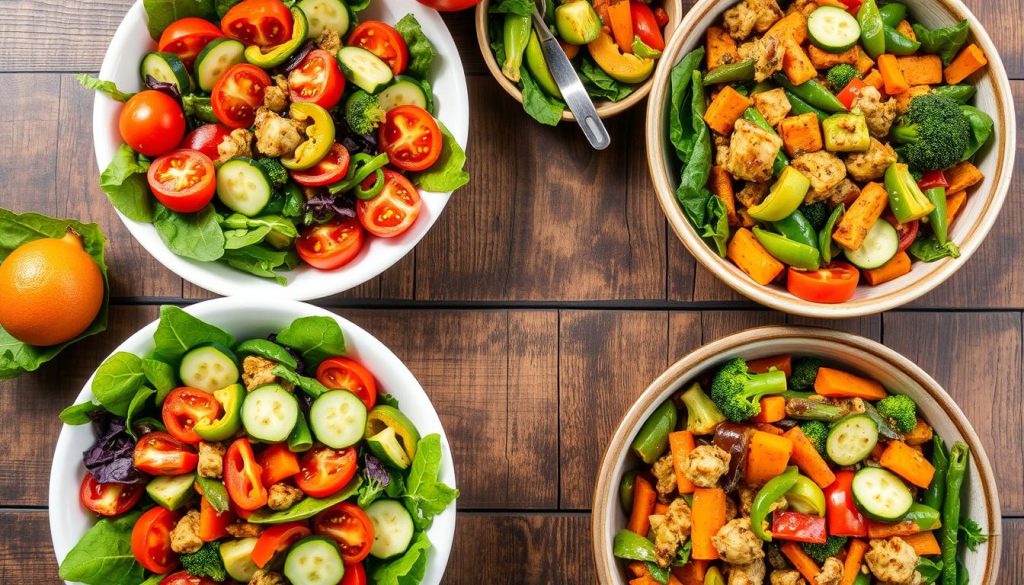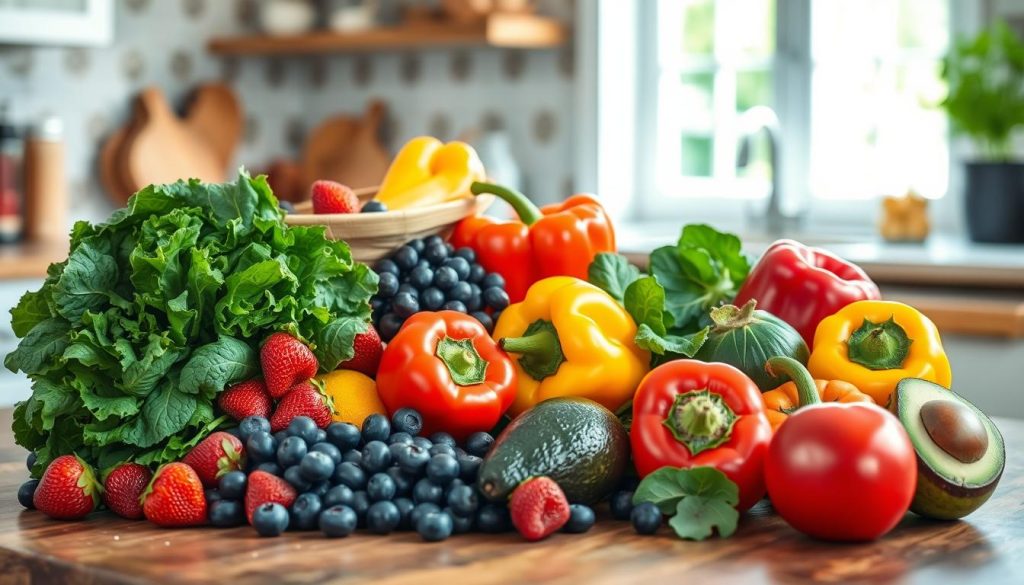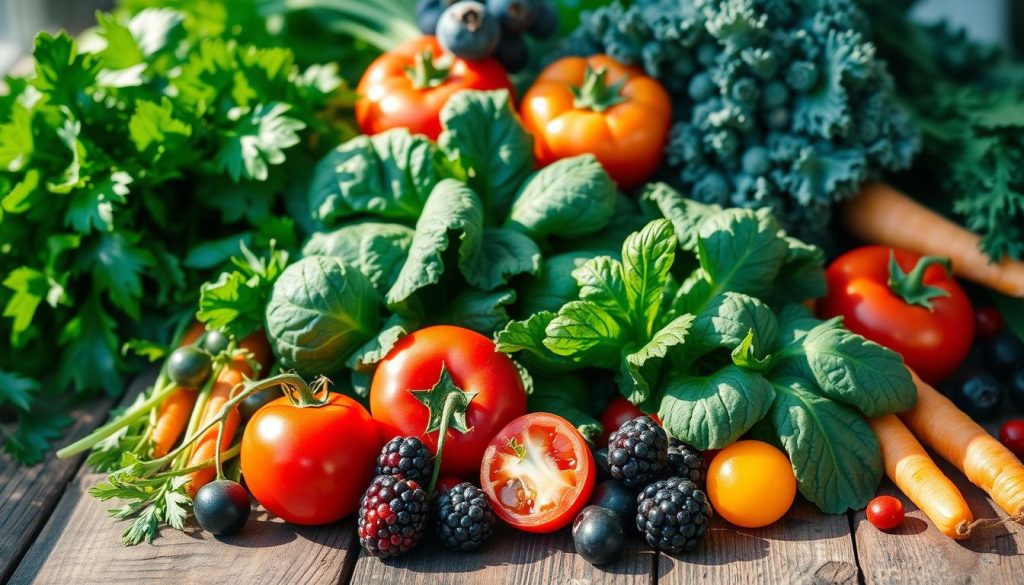Starting my weight loss journey, I found out how powerful fruits and vegetables are. They are full of vitamins, fiber, and nutrients that help with a healthy diet. These snacks are made by nature.
Eating a variety of fruits and vegetables can help you lose weight and lower disease risks. Grapefruit, apples, berries, and stone fruits are great for weight loss. They are packed with nutrients.
Key Takeaways
- Fruits and vegetables are low in calories and high in fiber, which can aid in weight loss
- Certain fruits like grapefruit, apples, and berries are particularly effective for weight management
- Incorporating a variety of fiber-rich produce into my diet can help me feel fuller for longer and reduce cravings
- Choosing whole fruits over juices and frozen or canned options over processed ones can maximize the nutritional benefits
- Substituting high-calorie ingredients with low-calorie fruits and vegetables can be a simple yet effective weight loss strategy
Understanding the Power of Nutrient-Dense Foods for Weight Loss
To lose weight, you need to eat fewer calories than your body burns. Fruits and vegetables are low in fat and calories. They also have water and fiber, making you feel full on fewer calories. This is how a low-calorie diet helps you lose weight.
The Science Behind Caloric Deficit
Weight loss comes from eating fewer calories than your body needs. Foods like fruits and vegetables are great for this. They give you important vitamins and minerals without extra calories found in processed foods.
Why Natural Produce Matters for Weight Management
For weight loss, focus on whole foods like nutrient-dense foods. Unlike refined carbs or added sugars, these fiber-rich produce options keep you full longer. This helps you avoid eating too much and supports a wholesome weight loss journey.
Role of Fiber in Weight Loss
- Fiber slows down digestion, helping you feel satisfied for longer periods.
- High-fiber diets from fruits and vegetables help with weight loss, increase fullness, and improve gut health.
- Soluble fiber absorbs water, forming a gel-like substance that slows the emptying of the stomach and the absorption of nutrients.
“Consuming more fiber-rich produce is a simple yet powerful strategy for wholesome weight loss.”
Best Fruits and Vegetables to Lose Weight
Fruits and vegetables are key for losing weight. They are low in calories but full of vitamins, minerals, and fiber. These nutrients help you on your weight loss journey.
Some top fruits and vegetables to lose weight include:
- Leafy Greens: Kale, spinach, and Swiss chard are great. They are low in calories and high in fiber. This makes you feel full and satisfied.
- Cruciferous Vegetables: Broccoli, cauliflower, Brussels sprouts, and cabbage are full of antioxidants. They help with weight loss.
- Berries: Blueberries, raspberries, and blackberries are antioxidant-rich produce. They help control blood sugar and support healthy weight.
- Citrus Fruits: Grapefruit, oranges, and lemons are hydrating fruits and veggies. They boost metabolism and make you feel full.
- Stone Fruits: Peaches, nectarines, and plums are low in calories and high in fiber. They are great for weight loss.
| Fruit/Vegetable | Calories per Serving | Fiber (g) | Water Content (%) |
|---|---|---|---|
| Carrot | 25 | 2.9 | 88 |
| Lentils | 115 | 7.8 | 70 |
| Pear | 100 | 5.5 | 84 |
| Raspberry | 64 | 8 | 86 |
| Spinach | 7 | 1 | 27 |
Adding these fruits and vegetables to lose weight to your diet helps you reach your goals. They provide essential nutrients, increase fullness, and support health.
https://www.youtube.com/watch?v=2uVPZWxVUs8
“A 2020 study found that women who increased their intake of whole fruits and vegetables experienced healthy long-term weight loss, reduced risk of becoming overweight or obese, and were better able to portion control and slow their eating speed.”
Low-Calorie Fruits That Boost Fat Burning
Shedding extra pounds might be easier than you think. Look to your fruit basket for help. Some fruits are low in calories but high in nutrients. They can boost your metabolism and aid in weight loss. Let’s look at the best fruits for a low-calorie diet.
Citrus Fruits and Metabolism
Citrus fruits like grapefruit and oranges are low in calories but rich in vitamin C. Vitamin C is a strong antioxidant that boosts your metabolism-boosting foods. Eating grapefruit can help with weight loss by improving insulin resistance.
The tartness of citrus fruits can also reduce cravings. This makes it easier to follow a healthy diet.
Berries and Blood Sugar Control
Berries, like blueberries, raspberries, and blackberries, are superfoods. They are low in calories and high in fiber. They also have a low glycemic index, which prevents blood sugar spikes.
This is good for weight management. Stable blood sugar prevents energy crashes and cravings.
Stone Fruits for Weight Management
Stone fruits, such as peaches, nectarines, and plums, are also great for weight loss. They are low in calories and full of nutrients. They may even help fight obesity-related diseases.
Their high fiber content helps you feel full. This makes them a smart choice for weight loss.
Adding these fruits to your daily routine can change your weight loss journey. They provide the nutrients your body needs while supporting your health and fitness goals.
Power-Packed Vegetables for Weight Loss
Vegetables are a powerhouse for weight loss. They include leafy greens and cruciferous veggies. These foods are full of fiber and can help you lose weight.
Leafy greens like kale, spinach, and Swiss chard are low in calories but high in fiber. They make you feel full and give you important vitamins and minerals.
Cruciferous veggies, such as broccoli, cauliflower, and Brussels sprouts, are also great. They have lots of fiber and protein, which helps with weight control. These veggies may also fight inflammation and boost your metabolism.
Hot peppers are another fat-burning food. The capsaicin in chili peppers can reduce hunger and increase metabolism. This helps your weight loss efforts.
Even though avocados are high in fat, they can help prevent fat storage. Their healthy fats keep you full and satisfied, making it easier to reach your weight loss goals.
Adding these nutrient-dense, fiber-rich, and hydrating fruits and veggies to your diet can help you lose weight. A balanced diet with whole foods is essential for lasting weight management.
Cruciferous Vegetables and Their Weight Loss Benefits
Adding cruciferous vegetables to your diet can change your weight loss game. Broccoli, cauliflower, and Brussels sprouts are full of fiber, protein, and good stuff that helps with weight control.
Anti-inflammatory Properties
Studies show that eating more cruciferous veggies can lower cancer risks. This includes breast, pancreatic, bladder, lung, prostate, and colon cancers. Their anti-inflammatory effects can help with weight loss too.
Protein Content in Cruciferous Vegetables
One cup of broccoli has 5 grams of fiber, which is a big part of what we need daily. These veggies also have a lot of protein, which is great for losing weight. For example, 1 cup of cauliflower has 27 calories, 5g of carbs, 2g of fiber, and 2g of protein.
Cooking Methods for Maximum Benefits
Choosing the right way to cook cruciferous veggies is key. Steaming or roasting keeps more nutrients than boiling or overcooking. The USDA has recipes to help you cook these veggies right for healthy weight loss.
“Cruciferous vegetables are linked with lower rates of many chronic diseases, including cancer and heart disease.”
By adding these veggies to your diet, you can lose weight healthily. They’re full of fiber, protein, and nutrients that boost your health and well-being.
How to Incorporate These Foods Into Your Daily Diet
Adding nutrient-rich fruits and veggies to your daily meals is crucial for healthy eating. Begin by adding fresh berries to your cereal or spinach to your omelet. For lunch, try a sandwich or wrap loaded with veggies or a vegetable-based soup.
At dinner, replace some meat or grains with roasted veggies like broccoli or Brussels sprouts. Snack on whole fruits like apples or oranges instead of junk food. Choose whole fruits over juice to get more fiber.
Try different cooking methods to make your meals tasty and healthy. Steaming, roasting, or sautéing brings out the best in your veggies. With a bit of creativity, you can make these foods a part of your daily diet and support healthy weight loss.
- Start your day with a fruit-topped breakfast cereal or veggie-packed omelet
- Pack lunches with veggie-loaded sandwiches, wraps, or soups
- Swap out some meat or grains for extra servings of roasted vegetables at dinner
- Snack on whole fruits like apples or citrus fruits throughout the day
- Experiment with different cooking methods to keep meals interesting and nutritious
“Eating a diet rich in fruits and vegetables is not only good for your overall health, but it can also support your weight loss goals. The key is finding ways to make these nutrient-dense foods a regular part of your daily routine.”

Smart Substitutions for Maximum Weight Loss Results
Reaching your weight loss goals is more than just cutting calories. It’s about making smart food choices. Adding more clean eating habits and meals full of wholesome produce can unlock the power of nutrient-dense foods for lasting weight management.
Meal Planning Strategies
Replace high-calorie ingredients with low-calorie fruits and veggies in your favorite dishes. Swap regular pasta for spiralized zucchini or mashed potatoes for cauliflower. These swaps can cut your calorie intake by 100 to 200 calories daily, helping you lose weight.
Portion Control Guidelines
Controlling your portions is key to weight loss. Use smaller plates to help you eat less. Fill half your plate with colorful fruits and veggies. This way, you’ll eat fewer calories and get more nutrients.
Healthy Snacking Options
Choose snacks that are low in calories but high in nutrients. A medium apple has 72 calories, a cup of blueberries has 83 calories, and carrots with hummus have 91 calories. Swapping sugary or salty snacks for these options can greatly help your weight loss.
By making these smart swaps, you can enjoy the benefits of clean eating and wholesome weight loss without losing flavor or satisfaction. Remember, small changes can lead to big results in achieving your health and fitness goals.
| Food Swap | Calorie Difference |
|---|---|
| Regular Pasta vs. Spiralized Zucchini | 100-200 calories saved |
| Mashed Potatoes vs. Mashed Cauliflower | 100-200 calories saved |
| Soda vs. Fancy Water | 100-200 calories saved |
| Fruit Juice vs. Smoothies | Increased fiber and protein |
| Dried Fruit vs. Fresh Fruit | Lower calorie and higher fiber |
| Fruit Dip vs. Peanut Butter | Lower sugar and higher healthy fats |
| Milk Chocolate vs. Dark Chocolate | Lower sugar and higher cocoa content |
| Potato Chips vs. Popcorn | 31 calories per cup for popcorn |
| Tortillas/Buns vs. Lettuce Leaves | Lower calorie and carb intake |
| White Bread vs. Whole Grain Bread | Higher protein and fiber |
| White Rice vs. Brown/Wild Rice | More nutrients and fiber |
| Mashed Potatoes vs. Mashed Sweet Potatoes | Lower carb and higher nutrient content |
| Red Meat vs. Lean Protein | Balanced protein and healthy fats |
| Sugary Cereal vs. Oatmeal | Avoids sugar crashes |
| Full-Fat Dairy vs. Fat-Free Dairy | Lower saturated fat intake |
| Fruit Yogurt vs. Greek Yogurt | Fewer calories and added sugars |
Common Mistakes to Avoid When Using Produce for Weight Loss
Fruits and vegetables are key for clean eating and weight loss. But, they can backfire if not used right. Here are some mistakes to steer clear of:
- Adding fruits and vegetables without reducing high-calorie foods. Just adding more produce won’t cut it. You need to cut back on other high-calorie foods too.
- Overindulging in fruit juices. Fruit juices might seem healthy, but they’re missing fiber. They’re also full of natural sugars, which can add up in calories.
- Overlooking added sugars in canned fruits and creamy vegetable dishes. Watch out for hidden sugars and high-calorie sauces. They can ruin the good of fresh produce.
- Relying solely on fruits and vegetables for weight loss. These foods are great, but they’re not enough. A balanced diet with lean proteins, whole grains, and healthy fats is key for lasting weight loss.
To get the most out of fruits and veggies, mix them into your meals and snacks. But, keep your diet balanced and controlled. The secret to lasting weight loss is clean eating and a healthy lifestyle.

| Common Mistake | Why to Avoid It |
|---|---|
| Adding fruits and vegetables without reducing high-calorie foods | Can lead to unintended weight gain |
| Overindulging in fruit juices | Lack fiber and high in natural sugars, contributing to calorie surplus |
| Overlooking added sugars in canned fruits and creamy vegetable dishes | Can undermine the benefits of nutrient-dense produce |
| Relying solely on fruits and vegetables for weight loss | A comprehensive approach that includes other macronutrients is essential for sustainable weight management |
“The key to successful and lasting weight loss lies in developing clean eating habits and a wholesome, sustainable approach.”
Conclusion
Adding lots of fruits and vegetables to my diet has really helped me lose weight. These foods are full of good stuff like vitamins, minerals, and fiber. They make me feel full and happy, and they help me stay healthy.
I’ve started choosing whole, unprocessed foods instead of processed ones. This has helped me stick to a healthy eating plan. Studies show that eating more veggies can help you lose weight. They also say it can lower the risk of gaining weight or becoming overweight.
I plan to keep eating clean and learning more about the benefits of fruits and veggies. With the right approach, I’m sure I can reach my weight loss goals. I’m excited to keep living a healthy, balanced life.


